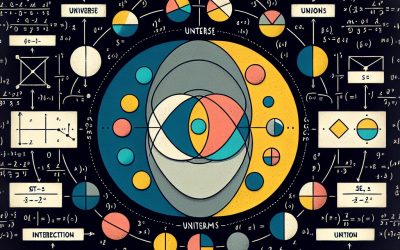➕ Introduction to Mathematics
The Language of Patterns, Logic, and Problem-Solving
Mathematics is the science of numbers, shapes, patterns, and relationships. It provides a universal language to describe the world around us—whether we’re counting, measuring, predicting, or solving complex problems. More than just calculations, maths is a way of thinking: logical, precise, and creative.
At its core, mathematics explores questions like:
-
How do we measure and compare things?
-
What happens when we follow certain rules or operations?
-
How can we predict outcomes or analyse patterns?
-
What structures exist beneath the surface of reality?
Maths is used in every area of life—from calculating a grocery bill to designing bridges, forecasting the weather, or sending spacecraft to Mars. It’s essential in science, engineering, technology, economics, architecture, and even music and art.
Divided into fields such as arithmetic, algebra, geometry, statistics, and calculus, mathematics grows more powerful as we explore deeper concepts. And it’s not just about finding the right answer—it’s about understanding why it’s right, and discovering new ways to think.
Studying maths sharpens our ability to reason, solve problems, and recognise the hidden patterns that shape our world.
Unlocking the Power of Eigenvalues and Eigenvectors: Understanding Their Importance in Linear Algebra
Eigenvalues and eigenvectors are fundamental concepts in linear algebra that have applications in various fields such as physics, engineering, and computer science. In simple terms, eigenvalues and eigenvectors are properties of a matrix that describe how it behaves when multiplied by a vector. An eigenvalue is a scalar that represents the scaling factor of the eigenvector when the matrix is multiplied by it. In other words, an eigenvector is a non-zero vector that remains in the same direction after the matrix transformation, but its length may change. Eigenvalues and eigenvectors play a crucial role in understanding the behavior of linear transformations and systems of linear equations. They provide insights into the structure and properties of matrices, allowing us to simplify complex calculations and solve problems efficiently. Key Takeaways Eigenvalues and eigenvectors are important concepts in linear algebra. Eigenvalues are scalar values that represent how a linear transformation changes the magnitude of a vector. Eigenvectors are non-zero vectors that remain in the same direction after a linear transformation. Eigenvalues and eigenvectors can be calculated using matrix operations. Eigenvalues and eigenvectors have applications in various fields such as principal component analysis, Markov chains, and quantum mechanics. The Concept of Eigenvalues and Eigenvectors Explained To understand eigenvalues and eigenvectors, let’s consider a simple example. Suppose we have a 2×2 matrix A and a vector When we multiply A by v, we get another vector Av. Now, if Av is parallel to v, then v is an eigenvector of A, and the scalar λ is the corresponding eigenvalue. Mathematically, this can be represented as Av = λv, where A is the matrix, v...
Exploring the Power of Vectors: How They Revolutionize Modern Technology
Vectors are a fundamental concept in mathematics and physics that play a crucial role in various fields, including technology, engineering, and science. They are used to represent quantities that have both magnitude and direction, making them essential for understanding and solving complex problems. From navigation systems to computer graphics, vectors are at the heart of many modern technologies. In this article, we will explore the basics of vectors, their applications in different fields, and the future of vector-based technologies. Key Takeaways Vectors are mathematical objects that have both magnitude and direction. Vectors play a crucial role in modern technology, including computer graphics, GPS, robotics, and artificial intelligence. Vector calculus is a powerful tool for solving complex problems in physics and engineering. Vector-based machine learning is a game-changer in artificial intelligence, enabling more accurate predictions and faster processing. The future of vector-based technologies is promising, with trends pointing towards increased use in fields such as healthcare and renewable energy. Understanding the Basics of Vectors: A Comprehensive Guide A vector is a mathematical object that represents a physical quantity with both magnitude and direction. It can be represented by an arrow, where the length of the arrow represents the magnitude of the vector, and the direction of the arrow represents its direction. Vectors have several properties, including addition, subtraction, scalar multiplication, dot product, vector projection, and cross product. Vector addition is the process of combining two or more vectors to obtain a resultant vector. It follows the commutative and associative properties, meaning that the order in which vectors are added does not matter, and they can be grouped together in any...
Mastering Matrices: A Comprehensive Guide to Understanding and Applying Matrix Algebra
Matrices are a fundamental concept in mathematics and have wide-ranging applications in various fields. In simple terms, a matrix is a rectangular array of numbers, symbols, or expressions arranged in rows and columns. Each element in the matrix is called an entry. Matrices are denoted by capital letters, and the number of rows and columns is indicated by subscripts. The importance of matrices lies in their ability to represent and manipulate complex data sets. They are used extensively in fields such as physics, computer science, economics, engineering, and more. For example, in physics, matrices are used to represent physical quantities such as forces, velocities, and electric fields. In computer science, matrices are used for image processing, data analysis, and machine learning algorithms. In economics, matrices are used to model economic systems and analyze market trends. To illustrate the importance of matrices in real-life situations, consider the following examples. In transportation planning, matrices can be used to represent the flow of traffic between different locations. In genetics, matrices can be used to represent genetic traits and analyze inheritance patterns. In finance, matrices can be used to model investment portfolios and analyze risk and return. Key Takeaways Matrices are arrays of numbers that can be used to represent and manipulate data in a variety of fields. Basic matrix operations include addition, subtraction, and scalar multiplication, which can be used to combine and transform matrices. Matrix multiplication is a more complex operation that involves multiplying corresponding elements and summing the results, and is important for many applications. Inverse matrices are matrices that can be multiplied by another matrix to produce the identity...
Unlocking the Power of Data: How Linear Algebra is Revolutionizing Analytics
Linear algebra is a branch of mathematics that deals with the study of vectors, vector spaces, and linear transformations. It plays a crucial role in the field of analytics, as it provides the mathematical foundation for many important concepts and techniques used in data analysis, machine learning, and data science. In the world of analytics, linear algebra is used to represent and manipulate data in a structured and efficient manner. It allows analysts to perform complex calculations and solve problems that would otherwise be difficult or impossible to solve. By using linear algebra, analysts can uncover hidden patterns in data, make predictions, group similar data points together, and optimize processes. Key Takeaways Linear algebra is crucial in analytics for solving complex problems and uncovering hidden patterns in data. Matrices and vectors are the basic building blocks of linear algebra and are used to represent data in a structured way. Linear regression uses linear algebra to predict outcomes by finding the best fit line through data points. Principal component analysis reduces data complexity by identifying the most important features and grouping them together. Singular value decomposition uncovers hidden patterns in data by breaking it down into its component parts. The Basics of Linear Algebra: Understanding Matrices and Vectors Matrices and vectors are fundamental concepts in linear algebra. A matrix is a rectangular array of numbers or symbols arranged in rows and columns. It can be used to represent data sets or transformations. A vector, on the other hand, is a one-dimensional array of numbers or symbols. It can be used to represent quantities such as position, velocity, or temperature. In...
Exploring Overlapping Interests: A Guide to Visualizing with Venn Diagrams
Venn diagrams are a powerful tool for visualizing and organizing information. They are named after John Venn, a British logician and philosopher who introduced them in the late 19th century. A Venn diagram is a graphical representation of sets or groups, using circles or other shapes to show the relationships between them. It is a way to visually represent the overlap or intersection of different elements. Key Takeaways Venn diagrams are a visual tool used to represent overlapping interests or sets. Understanding overlapping interests is important for identifying commonalities and differences between groups or concepts. The purpose of visualizing with Venn diagrams is to simplify complex information and make it easier to understand. Creating a Venn diagram involves drawing circles and labeling them with the appropriate information. Tips for designing effective Venn diagrams include using clear labels, consistent sizing, and avoiding clutter. Understanding Overlapping Interests Overlapping interests refer to areas or topics that have commonalities or shared characteristics. These can be anything from hobbies and interests to professional fields and academic subjects. For example, if someone is interested in both music and art, there may be an overlap in their appreciation for aesthetics and creativity. Overlapping interests can also occur in more complex scenarios, such as when analyzing data sets or comparing different groups of people. The Purpose of Visualizing with Venn Diagrams Venn diagrams serve several purposes when it comes to visualizing overlapping interests. Firstly, they provide a clear and concise representation of the relationships between different elements. By using circles or other shapes to represent sets, it becomes easier to see where the overlap occurs and how...
Mastering Set Operations: A Guide to Efficiently Manipulating Sets
Set operations are fundamental concepts in mathematics and computer science that involve manipulating collections of objects. A set is a collection of distinct elements, and set operations allow us to combine, compare, and manipulate sets in various ways. These operations are essential in many areas of mathematics, such as algebra, calculus, and probability theory, as well as in computer science, where they are used in data analysis, database management, and network analysis. Key Takeaways Set operations are used to manipulate and compare sets of data. Basic set operations include union, intersection, and complement. Union combines two sets into one, while intersection finds the common elements. Venn diagrams can be used to visualize set operations. Python offers efficient tools for manipulating sets. Understanding the Basic Set Operations The basic set operations include union, intersection, difference, and complement. The union of two sets A and B is the set that contains all the elements that are in either A or B (or both). The intersection of two sets A and B is the set that contains all the elements that are common to both A and B. The difference of two sets A and B is the set that contains all the elements that are in A but not in B. The complement of a set A with respect to a universal set U is the set that contains all the elements in U that are not in A. For example, let’s consider two sets A = {1, 2, 3} and B = {3, 4, 5}. The union of A and B is {1, 2, 3, 4, 5}, as it contains...
Exploring the Power of Sets: How Organizing Data Can Revolutionize Your Workflows
Sets are a fundamental concept in mathematics and data management. In simple terms, a set is a collection of distinct objects, called elements, that are grouped together based on a common characteristic or property. These elements can be anything, such as numbers, letters, or even other sets. Sets are denoted by curly braces {} and the elements are separated by commas. One important aspect of sets is that they do not contain duplicate elements. Each element in a set is unique and appears only once. This property makes sets particularly useful in data management, as it allows for efficient storage and retrieval of data. Additionally, sets can be used to perform various operations, such as union, intersection, and difference, which enable manipulation and analysis of data. Key Takeaways Sets are a fundamental concept in mathematics and computer science that represent a collection of unique elements. Sets can be used in data management to eliminate duplicates, simplify data structures, and improve efficiency. By using sets, you can streamline your workflow by reducing the time and effort required to manage and analyze data. Set theory can be applied to organize data into categories, subsets, and relationships, making it easier to understand and analyze. Sets play a crucial role in data analysis and visualization, allowing you to identify patterns, trends, and outliers in your data. The Advantages of Using Sets in Data Management Using sets in data management offers several advantages over other data structures. Firstly, sets allow for efficient storage and retrieval of data. Since sets do not contain duplicate elements, they eliminate the need to store redundant information. This not...
Exploring the Fascinating World of Set Theory: A Beginner’s Guide
Set theory is a fundamental branch of mathematics that deals with the study of sets, which are collections of objects or elements. It provides a framework for understanding the relationships between different objects and has applications in various fields such as mathematics, computer science, linguistics, and physics. In this article, we will explore the key concepts and principles of set theory, its historical development, and its importance in different disciplines. Key Takeaways Set theory is a branch of mathematics that studies sets, which are collections of objects. Sets are made up of elements and subsets, and set operations include union, intersection, and complement. Infinity plays a big role in set theory, with countable and uncountable sets. The axioms of set theory, including Zermelo-Fraenkel and Choice, provide a foundation for the subject. Set theory has applications in algebra, analysis, topology, and connections to computer science, linguistics, and physics. What is Set Theory and Why is it Important? Set theory is a branch of mathematical logic that was developed in the late 19th and early 20th centuries. It provides a formal language and framework for understanding collections of objects or elements. A set is defined as a well-defined collection of distinct objects, which can be anything from numbers to letters to abstract concepts. The development of set theory can be traced back to the work of mathematicians such as Georg Cantor, Richard Dedekind, and Gottlob Frege. Cantor’s work on the concept of infinity and his development of the theory of transfinite numbers laid the foundation for modern set theory. Dedekind introduced the concept of a set as a collection of objects...
Mastering Boolean Algebra: A Beginner’s Guide to Logic Gates and Truth Tables
Boolean Algebra is a branch of mathematics that deals with logical expressions and operations. It was developed by mathematician and logician George Boole in the mid-19th century. Boolean Algebra is based on the concept of binary logic, where variables can have only two possible values: true or false, represented by 1 or 0 respectively. The origins of Boolean Algebra can be traced back to the work of George Boole, who published his book “The Laws of Thought” in 1854. Boole’s work laid the foundation for modern computer science and digital electronics. His algebraic system provided a way to represent and manipulate logical expressions, which are essential for designing and analyzing digital circuits. Boolean Algebra plays a crucial role in computer science and digital electronics. It is used to design and analyze digital circuits, which form the building blocks of computers and other electronic devices. Boolean Algebra is also used in programming, databases, networking, and other areas of computer science. Understanding Boolean Algebra is essential for anyone working in these fields. Key Takeaways Boolean algebra is a system of mathematical logic used to represent and manipulate binary values. Logic gates are the basic building blocks of Boolean algebra, and can be combined to create complex circuits. Truth tables are used to represent logical expressions and determine their outputs for all possible input combinations. Boolean functions can be defined and simplified using algebraic rules and techniques. The laws of Boolean algebra provide fundamental rules for manipulating logical expressions and simplifying circuits. Logic Gates: The Building Blocks of Boolean Algebra Logic gates are electronic devices that perform logical operations on one or...
Unlocking the Power of Predicate Logic: A Guide to Logical Reasoning
Predicate logic, also known as first-order logic, is a formal system used to represent and reason about statements involving variables, predicates, and quantifiers. It is an extension of propositional logic, which deals with simple statements and logical connectives. Predicate logic allows for more complex statements by introducing variables that can take on different values and predicates that express relationships between these variables. Predicate logic is important in various fields such as philosophy, mathematics, computer science, and artificial intelligence. In philosophy, predicate logic is used to analyze and evaluate arguments, as well as to formalize philosophical theories. In mathematics, predicate logic is the foundation of mathematical proofs and provides a rigorous framework for reasoning about mathematical objects and structures. In computer science, predicate logic is used in programming languages and artificial intelligence systems to represent knowledge and make logical inferences. Key Takeaways Predicate logic is a formal system used to represent and reason about statements involving variables and quantifiers. Understanding terms, predicates, and quantifiers is essential to mastering predicate logic. The rules of inference provide a systematic way to make valid deductions in predicate logic. Predicate logic can be used to evaluate arguments and determine their validity. Common mistakes in predicate logic include confusing negation and contradiction, and failing to use parentheses correctly. Understanding the Basic Concepts of Predicate Logic: Terms, Predicates, and Quantifiers In predicate logic, terms are the basic building blocks that represent objects or individuals. They can be constants, variables, or functions applied to other terms. For example, in the statement “All cats are mammals,” “cats” and “mammals” are terms. Predicates are expressions that involve one or...
Unraveling the Mysteries of Propositional Logic: A Beginner’s Guide to Logical Reasoning
Propositional logic, also known as sentential logic or statement logic, is a branch of formal logic that deals with the study of propositions and their logical relationships. In propositional logic, propositions are statements that can be either true or false. These propositions are combined using logical connectives to form compound propositions, which can also be evaluated as true or false. The history of propositional logic can be traced back to ancient Greece, where philosophers like Aristotle and the Stoics developed systems of logic to analyze and evaluate arguments. However, it was not until the 19th and 20th centuries that propositional logic was formalized and studied extensively by mathematicians and logicians. Propositional logic plays a crucial role in critical thinking because it provides a framework for analyzing arguments and evaluating their validity. By breaking down complex arguments into simple propositions and examining their logical relationships, we can determine whether an argument is sound or fallacious. Propositional logic helps us identify logical fallacies, spot inconsistencies in reasoning, and make more informed decisions based on sound reasoning. Key Takeaways Propositional logic is a branch of logic that deals with propositions and their relationships. Propositional logic is important in critical thinking because it helps us to analyze arguments and identify fallacies. The components of propositional logic include propositions, connectives, and truth values. There are different types of propositional logic, including classical, intuitionistic, and modal. Propositional logic symbols and notations are used to represent propositions and their relationships. The Importance of Propositional Logic in Critical Thinking Propositional logic is an essential tool in critical thinking because it helps us analyze arguments and evaluate their...
Unleashing the Power of Logic: How to Improve Your Critical Thinking Skills
Critical thinking is a vital skill that is essential in both personal and professional life. It involves the ability to analyze and evaluate information, make logical and reasoned judgments, and solve problems effectively. In today’s complex and fast-paced world, critical thinking is more important than ever. It allows individuals to navigate through the vast amount of information available to them, make informed decisions, and adapt to new situations. Key Takeaways Critical thinking involves analyzing information and making reasoned judgments. Logic is essential in critical thinking to ensure sound reasoning and avoid fallacies. Biases and assumptions can cloud our thinking, so it’s important to identify and challenge them. A systematic approach to problem-solving involves breaking down complex issues into manageable parts. Practice is key to improving analytical skills, and effective communication is crucial in presenting arguments. Understanding the Basics of Critical Thinking Critical thinking can be defined as the process of actively and skillfully conceptualizing, applying, analyzing, synthesizing, and evaluating information to reach a conclusion or solve a problem. It involves being open-minded, asking questions, and challenging assumptions. Critical thinkers are able to identify biases and assumptions in their thinking, recognize logical fallacies, and make well-reasoned judgments. Some of the key characteristics of critical thinking include being objective, logical, rational, and reflective. Critical thinkers are able to separate fact from opinion, consider multiple perspectives, and weigh the evidence before making a decision. They are also able to think independently and creatively, using their own judgment rather than relying solely on the opinions of others. Critical thinking is crucial in decision-making because it helps individuals make informed choices based on evidence...














